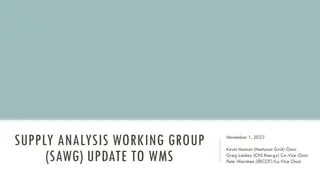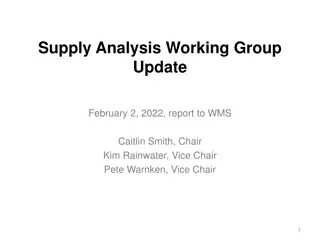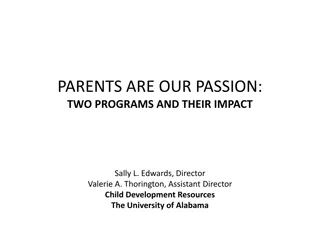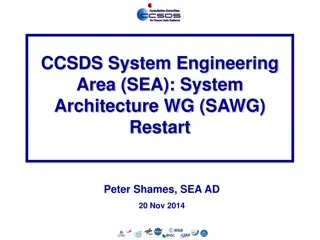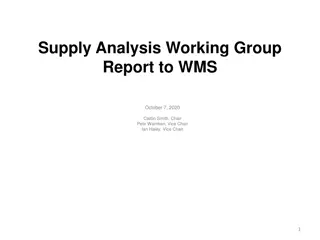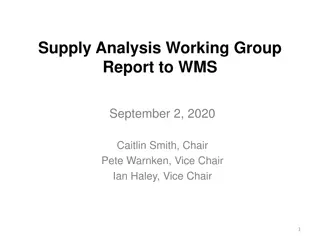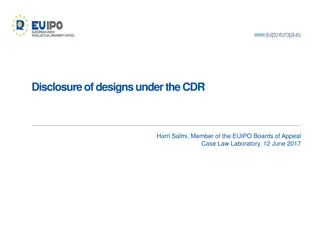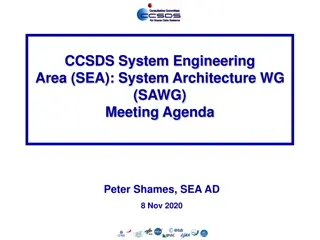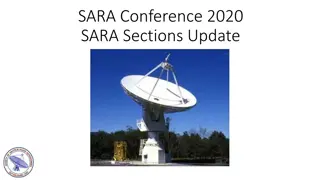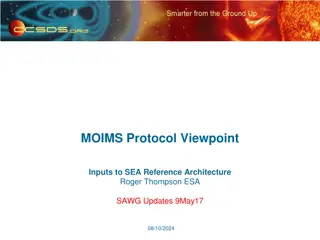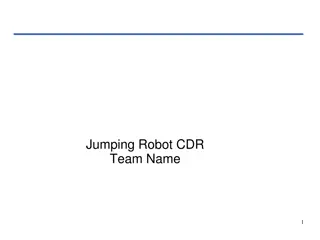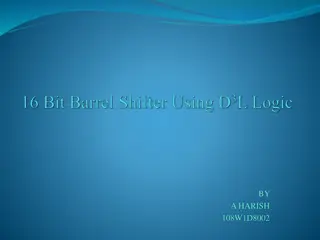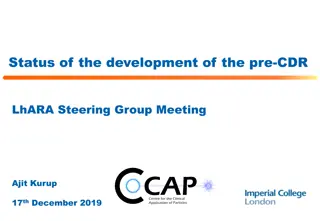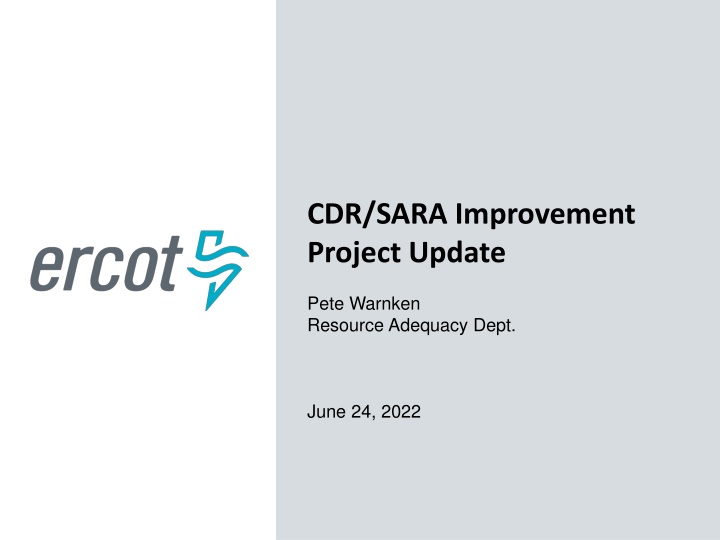
SARA Improvement Project Updates and Commissioner McAdams Memos
Explore the latest updates on the SARA improvement project including Commissioner McAdams' memos, highlighting the framework of principles for market rules, monthly reports, and more. Learn about rulemaking for registration of Flexible Loads, ELCC Study, and Capacity Accreditation Program Rationale.
Download Presentation

Please find below an Image/Link to download the presentation.
The content on the website is provided AS IS for your information and personal use only. It may not be sold, licensed, or shared on other websites without obtaining consent from the author. If you encounter any issues during the download, it is possible that the publisher has removed the file from their server.
You are allowed to download the files provided on this website for personal or commercial use, subject to the condition that they are used lawfully. All files are the property of their respective owners.
The content on the website is provided AS IS for your information and personal use only. It may not be sold, licensed, or shared on other websites without obtaining consent from the author.
E N D
Presentation Transcript
CDR/SARA Improvement Project Update Pete Warnken Resource Adequacy Dept. June 24, 2022
Commissioner McAdams CDR-SARA Memo / June 16 PUCT Open Meeting PUBLIC
Commissioner McAdams Memo / June 16 Open Meeting Highlights: Framework of principles to be in market rules by December 2022 that tie the CDR/SARA to Phase 2 market design Release CDR on a quarterly basis with seasonal outlooks Include probabilistic metric(s) (Lake) Gather stakeholder feedback on Reliability Standard and metrics in parallel with Consultant Phase 2 analysis (Cobos) Standards should support resiliency goals (McAdams) Put target publication dates in the Rules Should allow some flexibility though (Lake) Monthly SARA reports Identify downside seasonal scenarios that the fleet needs to prepare for to provide sufficient reliability (Lake) 3 PUBLIC
Commissioner McAdams Memo / June 16 Open Meeting, continued Rulemaking for voluntary registration of Large Flexible Loads and critical loads Tie to LFLTF progress (Lake) Other reforms, like load forecasting improvement, resource accreditation, and scenario analysis can be managed by ERCOT rather than codify in the Rules Continue to collaborate with the Commission Maintain data and methodology transparency for stakeholders 4 PUBLIC
ELCC Study PUBLIC
ELCC Study Rationale Develop a library of ELCC values that can be used in the CDR/SARA successor reports For example, given the forecasted mix of wind, solar and battery storage (along with technology types and other attributes) for a given future year, we would have ELCC values appropriate for those resource portfolios Lay the analytical groundwork for developing a capacity accreditation program that supports the future reliability obligation/standard (outcome of Phase 2 of the Market Design blueprint) 6 PUBLIC
ELCC Study Statement of Work Perform hourly analysis to obtain ELCC values for the following resource classes (total of up to 100 unique scenarios): Solar (25 50 GW in five GW steps with today s penetration of wind/storage Wind (35 60 GW in five GW steps with today s penetration of solar/storage Storage (5 30 GW in five GW steps with today s penetration of solar/wind) At one or more penetrations, test location effects on ELCC values for wind and solar At one or more penetrations, test fixed vs tracking technology effect on solar ELCC values 7 PUBLIC
ELCC Statement of Work, continued At one or more penetrations, test inverter loading ratio effects on solar ELCC values Increase wind/solar/storage in tandem up to max of +10 GW storage/ +20 GW solar/ +20 GW wind Simulations to understand average contribution of all existing solar, wind and storage Perform analysis to obtain ELCC values for high-risk hours of solar, wind, and storage at one selected penetration level 8 PUBLIC
ELCC Results Matrices ELCC Scenario Battery Duration (HR) Battery Penetration(GW) 1 4 2 4 3 4 4 4 5 4 6 4 7 4 8 4 9 4 10 4 11 4 12 4 13 4 14 4 15 4 16 4 17 4 18 4 19 4 20 4 21 4 22 4 23 4 24 4 25 4 26 4 27 4 28 4 29 4 30 4 31 4 32 4 33 4 34 4 35 4 36 4 37 38 39 40 41 42 43 44 45 46 47 48 49 50 51 52 53 54 Solar Penetration(GW) Wind Penetration(GW) 0 35 50 0 35 50 0 35 50 0 35 50 0 35 50 0 35 50 0 35 50 0 35 50 0 35 50 0 35 50 0 35 50 0 35 50 ELCC Scenario 1 2 3 4 5 6 7 8 9 10 11 12 Scenario Technology Wind-C Wind-P Wind-O Solar - Tracking Solar - Fixed Solar - BTMPV Solar - ILR Test 1 Solar - ILR Test 2 Solar - West Solar - East 1 HR Storage - A/S Eligible 1 HR Storage - A/S Ineligible Battery Penetration(GW) 2024 Portfolio 2024 Portfolio 2024 Portfolio 2024 Portfolio 2024 Portfolio 2024 Portfolio 2024 Portfolio 2024 Portfolio 2024 Portfolio 2024 Portfolio 2 2 Solar Penetration(GW) 2024 Portfolio 2024 Portfolio 2024 Portfolio 2024 Portfolio 2024 Portfolio 2024 Portfolio 2024 Portfolio 2024 Portfolio 2024 Portfolio 2024 Portfolio 2024 Portfolio 2024 Portfolio Wind Penetration(GW) 2024 Portfolio 2024 Portfolio 2024 Portfolio 2024 Portfolio 2024 Portfolio 2024 Portfolio 2024 Portfolio 2024 Portfolio 2024 Portfolio 2024 Portfolio 2024 Portfolio 2024 Portfolio 20 0 30 40 20 4 30 40 20 8 30 40 20 12 30 40 8 12 8 12 8 12 8 12 4 8 4 8 4 8 4 8 2024 Portfolio 1 + 10 GW from 2024 Portfolio 2024 Portfolio 2 + 10 GW from 2024 Portfolio 2024 Portfolio 2024 Portfolio 8 + 10 GW from 2024 Portfolio 2024 Portfolio 12 + 10 GW from 2024 Portfolio 2024 Portfolio 2024 Portfolio 2024 Portfolio 9 PUBLIC
Effect of Resource Attributes on ELCCs 10 PUBLIC
Thermal Resource ELCC Challenge for developing thermal resource ELCCs is to separate normal random outage variability from correlated outage variability due to extreme weather events and common mode failures (e.g., major gas pipeline outage) Current industry methods such as UCAP apply availability adjustments based on average Equivalent Forced Outage Rates for a seasonal time period; CAISO includes outages for just the tightest supply cushion hours) Will focus on February 2011 and 2021 Winter Storm Uri events as test cases for extreme cold weather/fuel limitation correlated outage evaluation 11 PUBLIC
Thermal Resource ELCC Results Matrix ELCC Scenario 1 2 3 4 5 6 7 8 9 10 11 12 13 14 15 16 17 18 Battery Penetration (GW) Solar Penetration (GW) Wind Penetration (GW) Thermal Penetration (GW) 0 Cold Weather Outage Assumption Fuel Availability Assumption 2024 Portfolio 2024 Portfolio 2024 Portfolio Exclude 2021 2024 Portfolio 0 0 0 0 2024 Portfolio 2024 Portfolio 2024 Portfolio Exclude 2011 and 2021 Exclude 2021 2024 Portfolio 0 0 0 0 2024 Portfolio 2024 Portfolio 2024 Portfolio Include 2011 and 2021 2024 Portfolio 0 0 0 0 2024 Portfolio 2024 Portfolio 2024 Portfolio Exclude 2021 2024 Portfolio 0 0 0 0 2024 Portfolio 2024 Portfolio 2024 Portfolio Exclude 2011 and 2021 Include 2021 2024 Portfolio 0 0 0 0 2024 Portfolio 2024 Portfolio 2024 Portfolio Include 2011 and 2021 2024 Portfolio 0 0 0 12 PUBLIC
ELCC for Other Resource Types Private Use Network Generators and PUN Generators with co-located loads - TBD Interruptible Loads - TBD 13 PUBLIC

